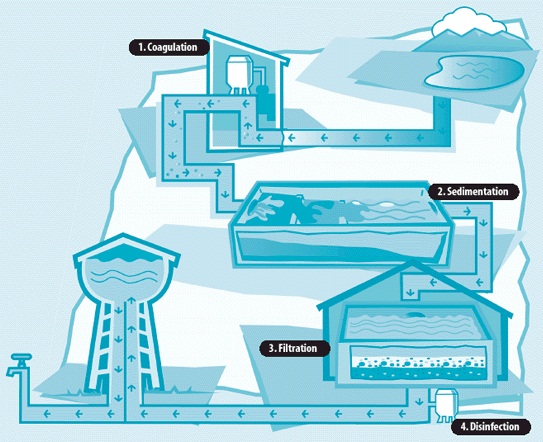
Water treatment basics
June 20, 2025
Water treatment steps

Water utilities across the country have in place effective processes to remove contaminants that cause waterborne diseases. The most commonly used processes include coagulation/flocculation/sedimentation, filtration and disinfecton.
Coagulation/Flocculation/Sedimentation
The flocculation process coagulates (joins together) particles with alum and metal salts so that they settle out of the water as sediment. Sedimentation is simply a gravity process that removes flocculated particles from the water.
Filtration
Filtration removes remaining particles from the water supply. Those particles may include silt, natural organic matter, iron and manganese, and microorganisms. Filtration clarifies water and improves the effectiveness of disinfection.
Disinfection (Chlorination)
Following coagulation, flocculation, sedimentation and filtration, water is disinfected to ensure that dangerous microbes are killed. Chlorine- based disinfectants are most commonly used because they are very effective. Chlorine- based disinfectants also provide residual protection against biological contamination in the water distribution system. This is a critical step to assure our water is safe all the way to the consumer’s tap.The circumstances will than be suitable for disinfection, because the larger part of pathogenic microorganisms present in the water will be removed during primairy water purification.
Dissolved and floating particles must be removed from water, because these may react with disinfectants to disinfection byproducts and because they are a substrate for microorganisms. Moreover, microorganisms are harder to remove from water when adsorption to floating particles in water takes place. The concentrations of floating particles in water must be low when disinfection is apllied, preferably below 1 mg/L. Chemical substances that are present in water through human or natural causes may also influence disinfection. The substances react with disinfectants to disinfection byproducts. This causes the concentration of disinfectants needed to properly remove microorganisms to be much higher. It is also harder to maintain a residual concentration.
Adequate waste water treatment can make the disinfection of drinking water more efficient. This is often neglected. When waste water treatment is insufficient, water that is polluted with all kinds of pathogenic microorganisms and chemical pollutants will end up in the environment. This negatively influences the environment, mainly surface water quality.


